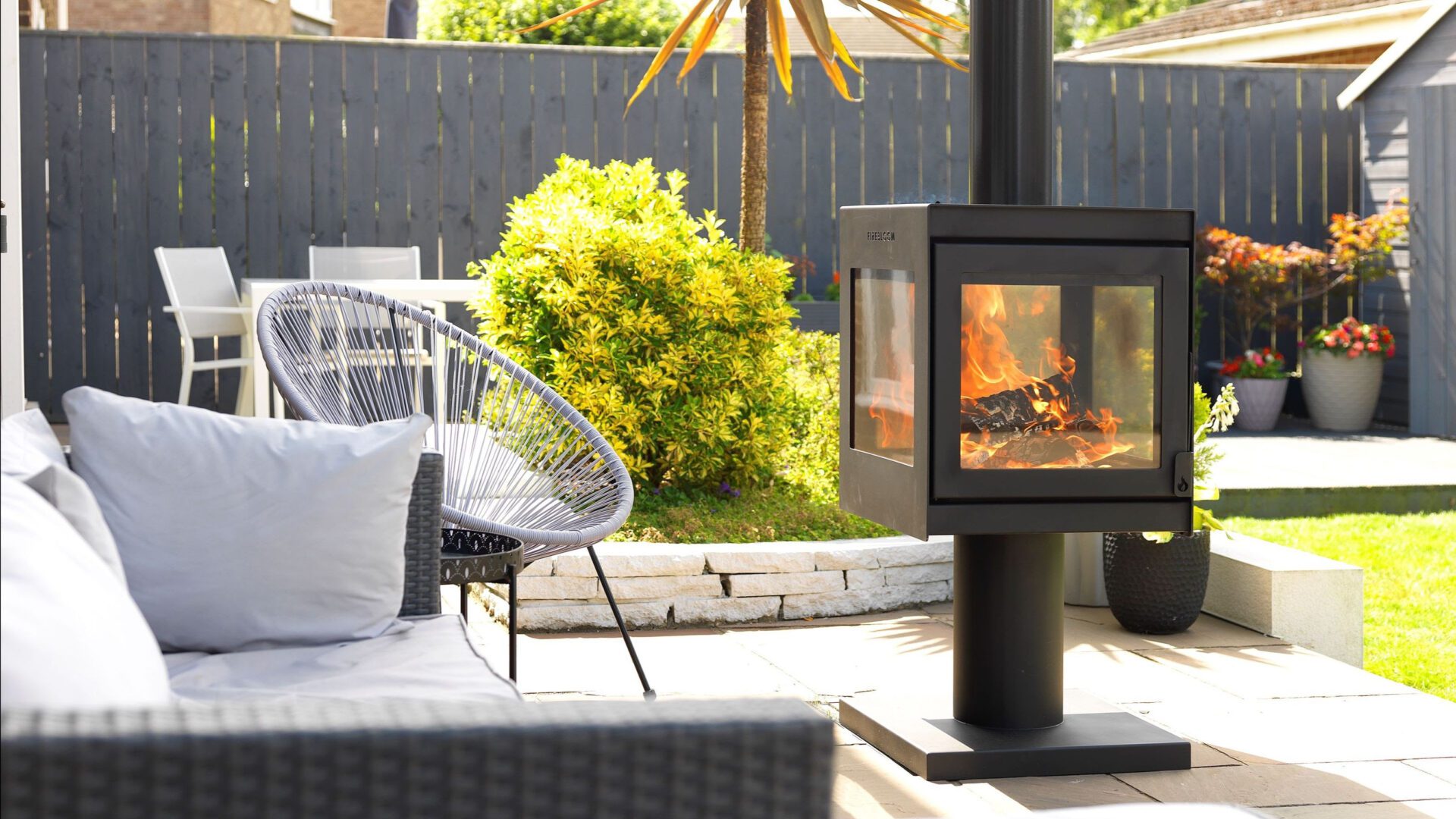
8 outdoor heating options to take your garden from day to night
Even on the warmest of days, the setting of the sun and the drop in temperature that comes with it can quickly put a premature end to any outdoor gathering. So if you want the party to continue after dark, you’re wise to invest in some decent outdoor heating.
There are lots of effective options – all with their pros and cons. For example, the sight, scent and sound of a crackling fire pit or wood burner can make an evening outdoors feel nostalgic, snug, and even romantic in the right setting. But you’ll also need space to store the wood needed to fuel it and be wary of the smoke created. On the other hand, gas and electric infra-red burners produce clean, fast heat but aren’t always pretty, and will usually require propane storage or somewhere to mount them.
So which heat source is right for you? With the help of a panel of experts, we’ll walk you through all the choices for a warmer garden that you’ll hopefully come to use all year round.
1. Warm up a crowd with a low-slung fire pit
One of the most affordable options for outdoor heating is a good old-fashioned fire pit. They can generate significant heat to keep all your family and friends warm throughout the evening and utilise wood – a readily available renewable resource that can usually be sourced locally and sustainably.
“Fire pits are a great addition to any garden, no matter the size, as they combine aesthetic with utility,” agrees Jon Butterworth, director at Arada Stoves. “The smell of burning wood and the natural ambience that a fire pit creates is timeless, and something which instantly encourages people to gather around to socialise together.”
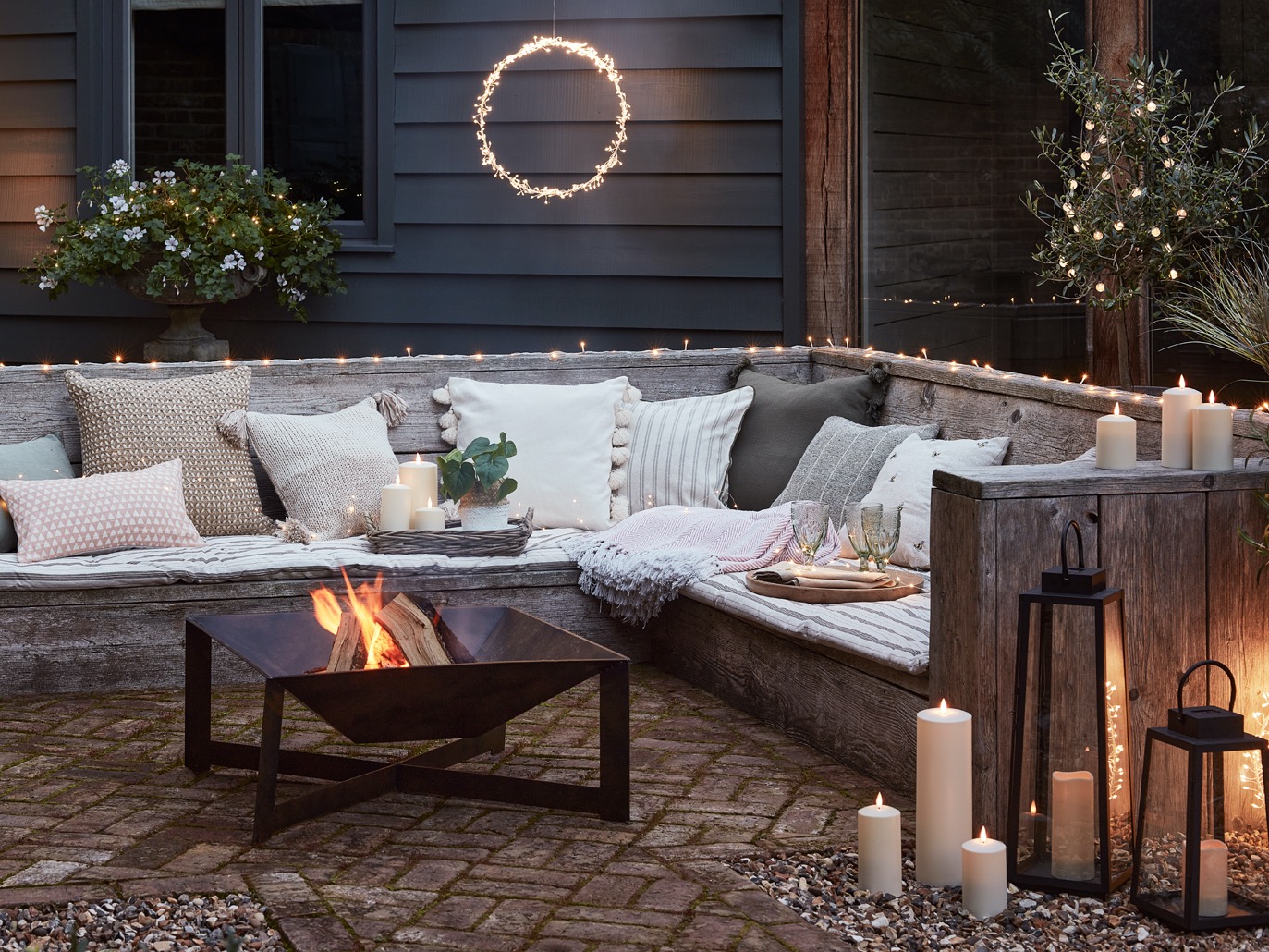
Fire pits don’t represent a big outlay, but you’re wise not to go too cheap when shopping for one. “Not all fire pits are built the same,” says Joanna Humphreys, fire and stove specialist at Direct Stoves. “It’s important to not compromise on quality or longevity as what may seem like a bargain at the time could end up costing you more in the long run.”
“Steer away from anything that feels too light or flimsy as it will be prone to wobbling, making it unsafe, especially around people and pets,” she says. “When you’re working with real flames, you need your firebase to be as robust as possible to avoid fire spreading. Also, look out for weatherproof and rust-proof materials as a lower-quality fire pit base can rust and fall away, making it completely unusable.”
A word on firewood for outdoor stoves and fire pits
Joanna Humphreys, fire and stove specialist at Direct Stoves, gives us her insight on the best wood to burn outdoors – and what to avoid. “There are two main categories of wood for outdoor fires: hardwood and softwood. Hardwood comes from deciduous trees like oak, maple, beech, and ash, which lose their leaves each autumn. Softwood comes from coniferous or evergreen trees like pine, spruce, and yew, which keep their needle-like leaves year-round,” she explains.
“In general, hardwoods are considered the better choice if you want a beautiful outdoor fire that’s long-lasting, efficient and clean-burning,” Joanna adds. “However, softwood can also be used, especially if hardwood is unavailable or too expensive. These logs are abundant in many regions and cost less per kilo.”
“It’s very important to avoid burning any type of treated wood in outdoor fires,” she warns, “because the preservatives and chemicals used to treat wood can release toxic fumes and smoke when burned.” Examples of treated wood are pressure-treated lumbar used for fences, sheds and garden decking, creosoted railways sleepers, painted and stained wood, and formaldehyde-bonded plywood or chipboard.
2. Make a statement with a contemporary chimenea
While bowl-style fire pits remind us all of old-school campfire gatherings, there are more design-forward ways to burn wood. Contemporary chimeneas offer an opportunity to introduce an extra element of sculpture to your garden. If you’re not so hot at keeping plants alive or want to make an impact in the lacklustre garden of a rented property, they could be just the statement you need.
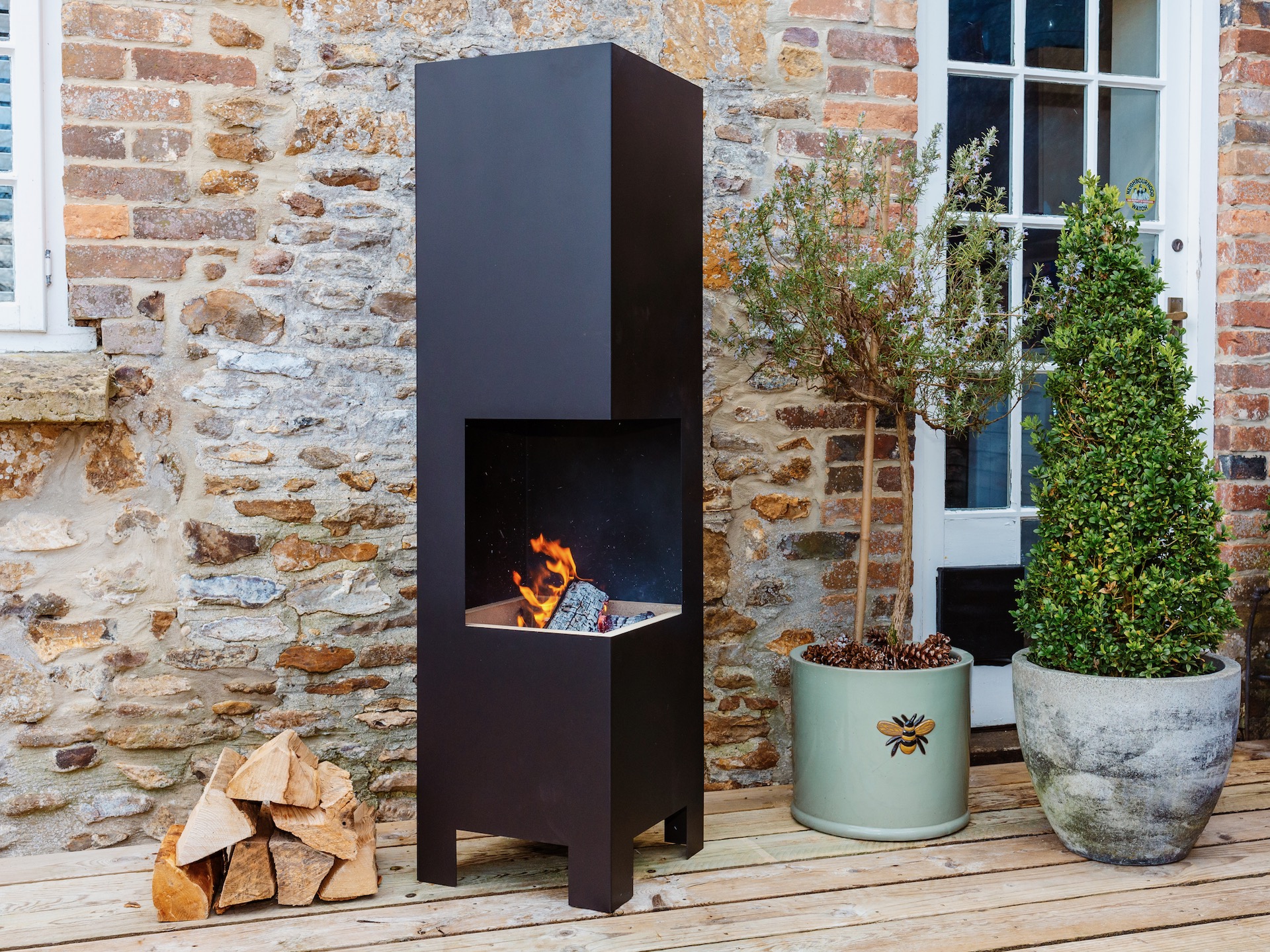
This stylish column-body deck chimenea by Arada, £399 at Stoves Are Us, has liner bricks so that your wood will burn hotter and longer, and is made from zinc-coated steel which is durable and weather-resistant. There is a removable ash pan included, so cleaning it out won’t make a mess and ruin the look.
3. Multitask with a heater-meets-oven
Make the most of the heat you create by choosing an outdoor stove that can double as an oven. Danish wood-burner manufacturer Morsø introduced its Forno grill more than a decade ago, introducing accessories that take it from strength to strength.
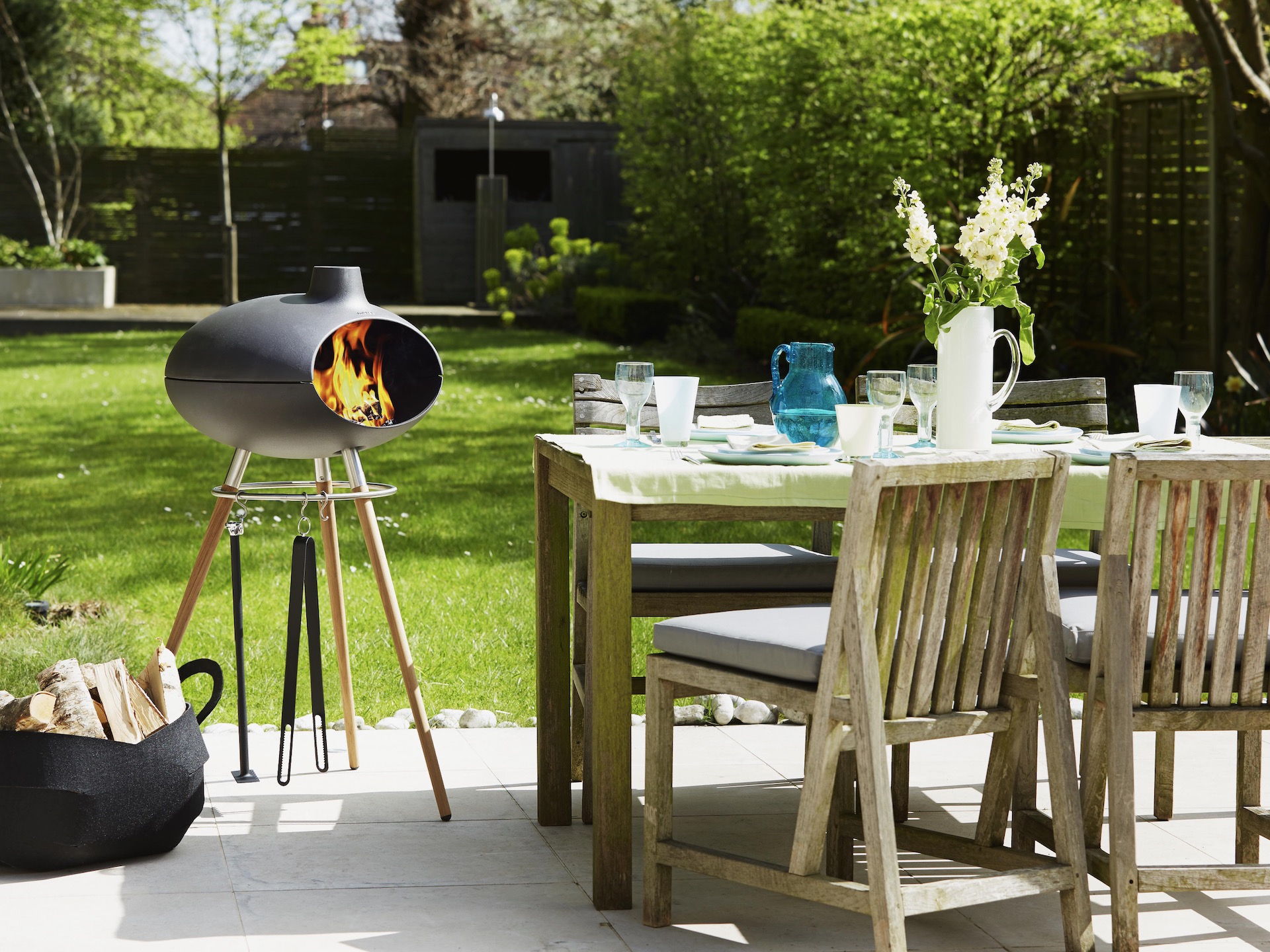
The wide base can serve as a fire pit, but a grill grate mounted above it also allows it to be used to cook meat. More extras (sold separately) can turn it into a pizza oven or a smoker. It comes with tripod legs so that the fire is at the perfect level to keep you warm when sitting at the table.
Shop the look: Forno Grill II, RRP £999, currently £699, Morsø
4. Save space with a wall-mounted infrared heater
They may not be as attractive as some other outdoor heating options, but infrared patio heaters can be a more discreet way of keeping you warm in the garden. Plus, they produce more effective radiant heat, compared to the convective heat from logs or gas (which is carried by the air).
“The warmth from infrared electric heaters travels through the air, directly warming the surfaces they reach. This makes them ideal for large indoor and outdoor spaces where heating by convection is very wasteful,” explains Gtech owner Nick Grey. “Traditional convection heaters like gas wood and halogen electric heat up the air around them and the air transfers the heat to you. Hence you must stand close to them and in cold windy conditions the heat pretty much blows away.”
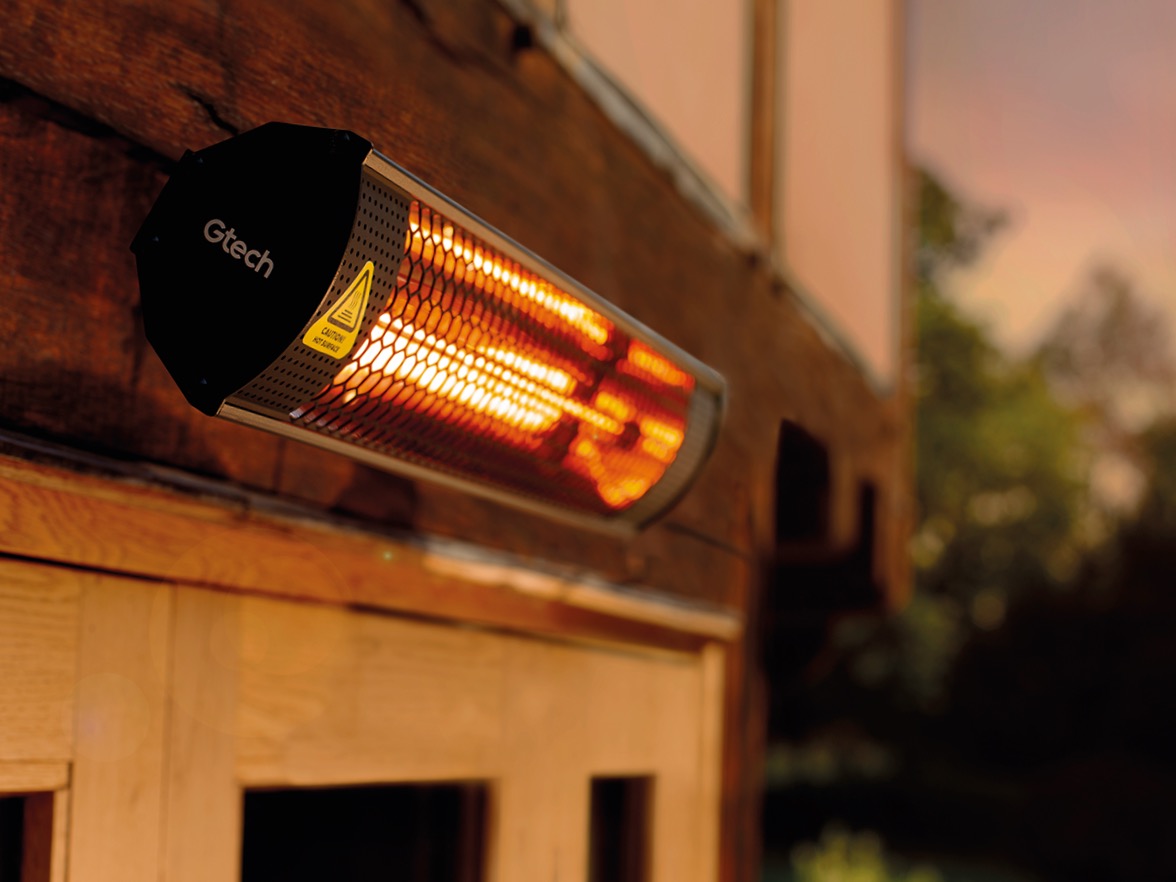
There are downsides to infrared heaters, as Nick points out: “You need to run a power supply to electric heaters and protect any plug sockets from moisture so installation can be more costly,” he says, “But once installed you can expect to save money on your heating costs if using infra-red and don’t have the faff of changing gas cylinders or fetching and lighting fuel.”
“It’s also fairly easy to calculate the running costs of an infrared heater once you find the right wattage – the amount of power – to fit your space,’ adds Stephen. ”For example, a 2,000-watt medium-wave patio heater should be able to heat a modest patio or decking area of about 12m2 and is likely to cost around £1.80 to run for three hours – more than enough time to keep things going once the sun has gone down.”
This compact but powerful plug-and-play GTech model heats an area of 6 sq m and is lightweight enough to be mounted to any wall or fence.
Shop the look: HeatWave patio heater, £149.99, GTech
5. Dine around a fire pit table
Our next option is a much bigger investment, but make sure to wow dinner guests (or at least distract them from overdone barbecue food) with a table with its own built-in fire pit. “Dining or bar tables with integrated fire pits can extend the usability of your garden well into the cooler weather,’ says Reilly Gray, co-founder of outdoor furniture specialist Suns Lifestyle. “Serving as a focal point, the fire pit will encourage interaction around the table whilst providing added warmth. The flicker of the flames will also enhance your overall garden design, casting light and shadows throughout the space.”
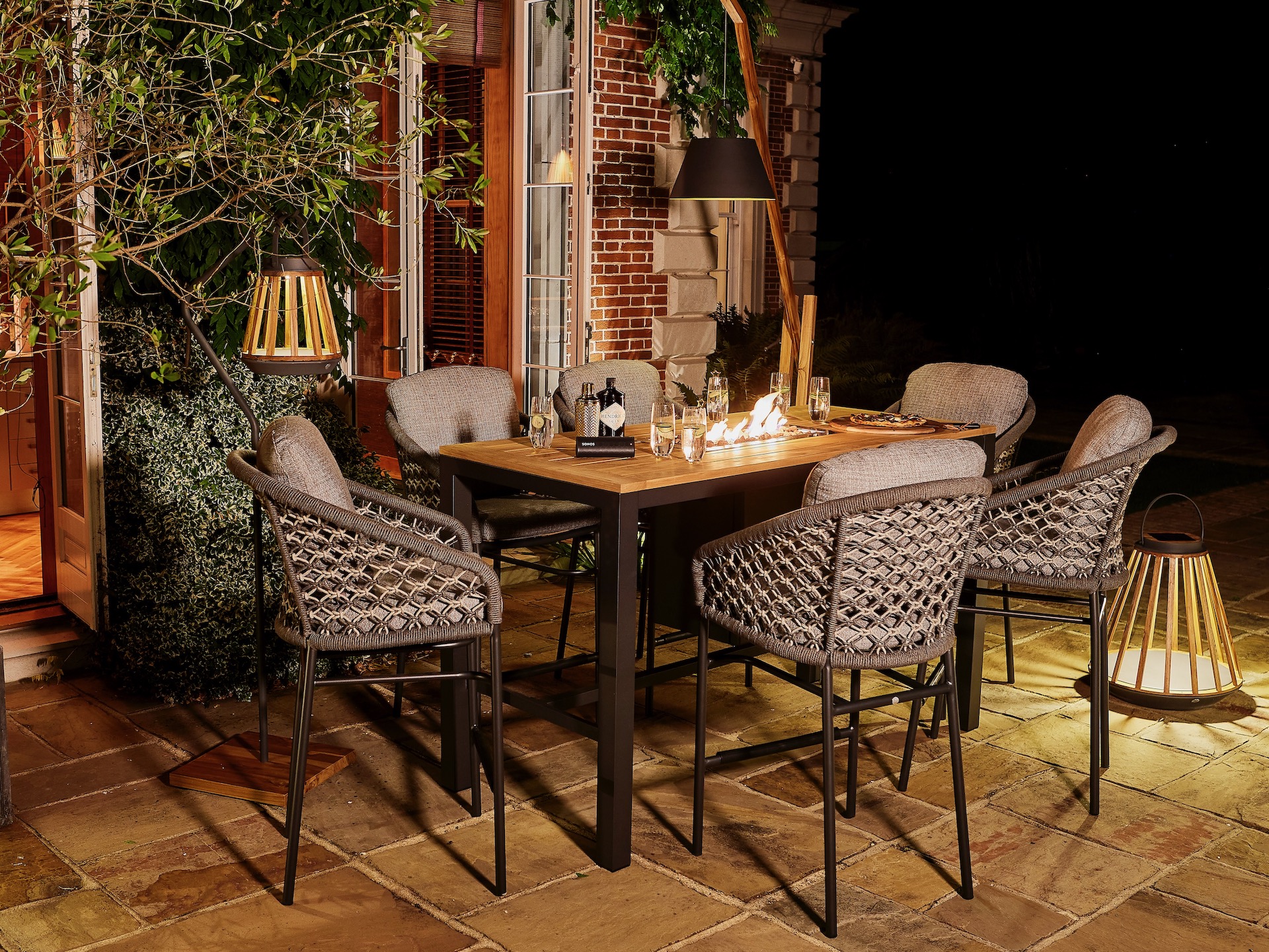
When you’re shopping for a similar design, check that the materials used are waterproof, fireproof and anti-corrosive so you can trust they can survive a life outdoors. Suns Lifestyle’s fire pit tables are powered by gas tanks that are hidden away in the leg of the table and come with a 17.5kW and 59,712 BTU output. They have an integral gas source and push-button ignition -all you do is simply press for 20 seconds to draw the gas throw and twist gently to ignite. All have metal fire pit lids to convert them into stand-alone tables as well and feature an adjustable flame, lava rocks and imitation logs.
We particularly recommend this Monte Vari Firepit and Nappa bar range, from £4,500, Suns Lifestyle, for anyone worried about very little fingers getting too close to the flames. Because it’s that little bit taller, children are less likely to be able to reach the central fire pit.
6. Warm up inside and out with a halogen heater
“Shortwave halogen heaters offer intense and immediate heat that is great for warming smaller areas such as a deck at the end of a long garden,” says Stephen. And because its heat is emitted by a halogen bulb, it can be used in a garage or workshop, too – unlike many outdoor heating options.
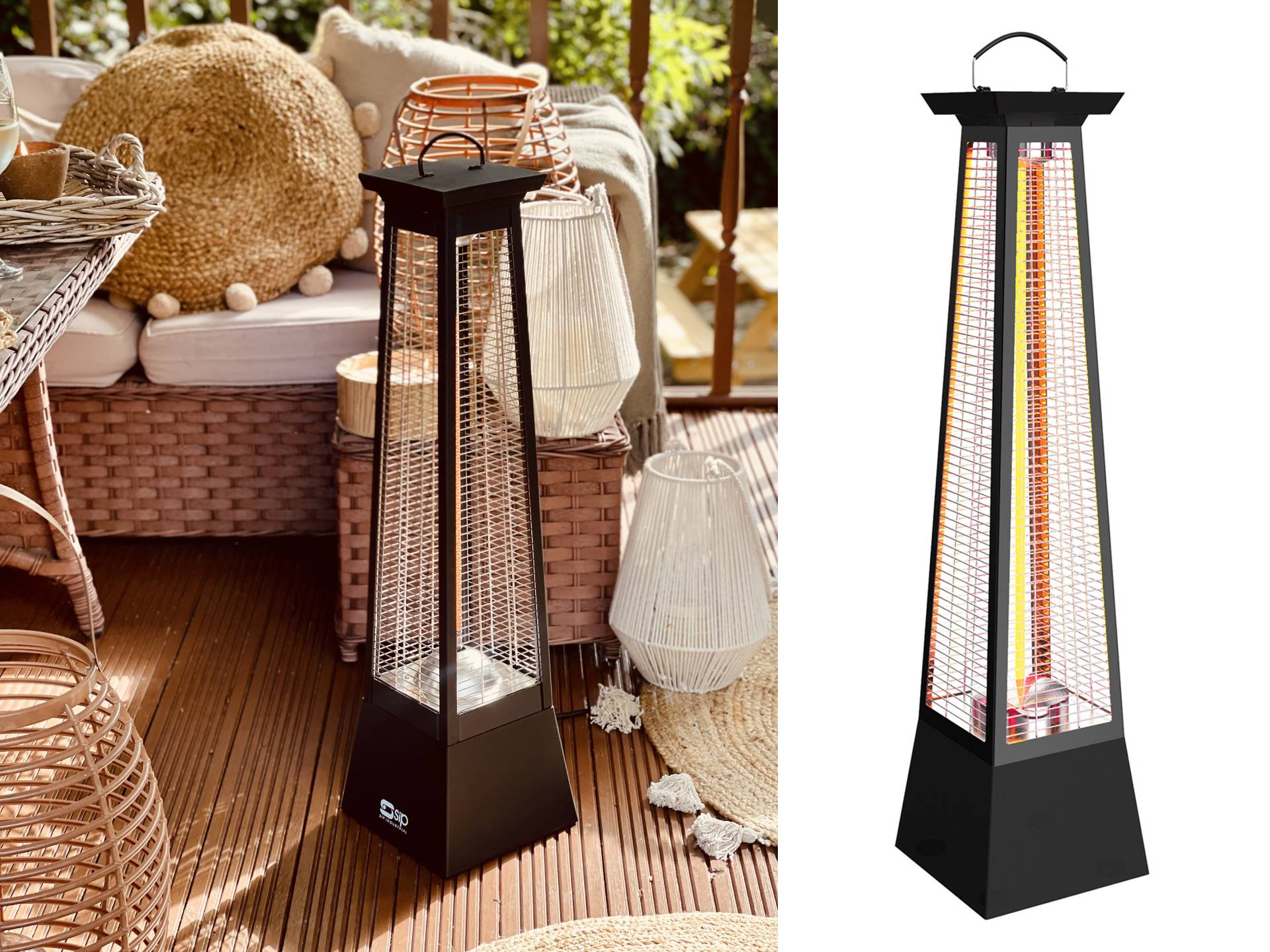
Another advantage of halogen heaters is, that because of the bulb, they give off a very consistent and bright light to see after dark. However, they aren’t always as efficient as their infrared counterparts.
Shop the look: 800mm-high SIP universal freestanding halogen heater, £151.99 plus VAT, BiGDUG
7. Save space with onboard log storage
Any wood burner is going to require a lot of logs to feed it, which will mean plenty of journeys back and forth to your garden’s covered wood store. This can be a bit of a nuisance when you’re simultaneously looking after guests – not to mention the fact that your visitors might want to have a go at tending the fire themselves.
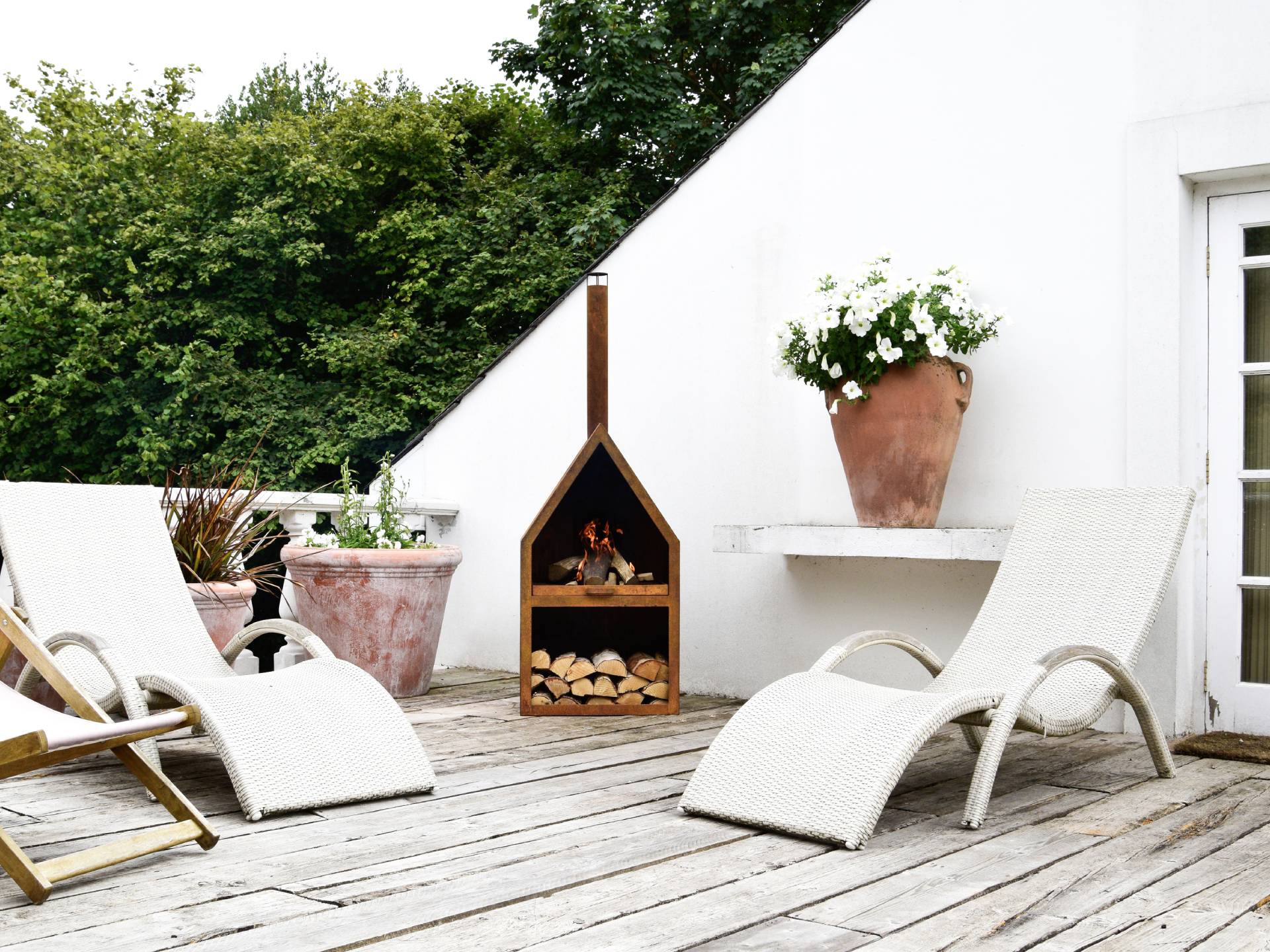
A good solution is to include a fire pit with storage built in for convenience – like this design by Ivyline. You may still want to keep more logs elsewhere, but there will be plenty of space for firewood for at least a weekend’s entertaining.
8. Have a fuss-free experience with gas
If a smokey fire pit doesn’t appeal, you’re not on board with the clean-up that a stove requires, and don’t want to be tied down by an electric heater’s wires, gas (natural or propane) is the logical option. Stoves that run off propane tanks aren’t always the cheapest option, but they are faff-free.
“Gas patio heaters are not only more decorative and aesthetically pleasing, they offer a warm ambient glow, similar to a real fire,” says Joanna Humphreys at Direct Stoves. “A design with four open sides gives maximum warmth as it emits convected heat, ensuring everyone is perfectly toasty. The attractive appearance and pleasurable warmth of a gas patio heater is the ideal addition when entertaining.”
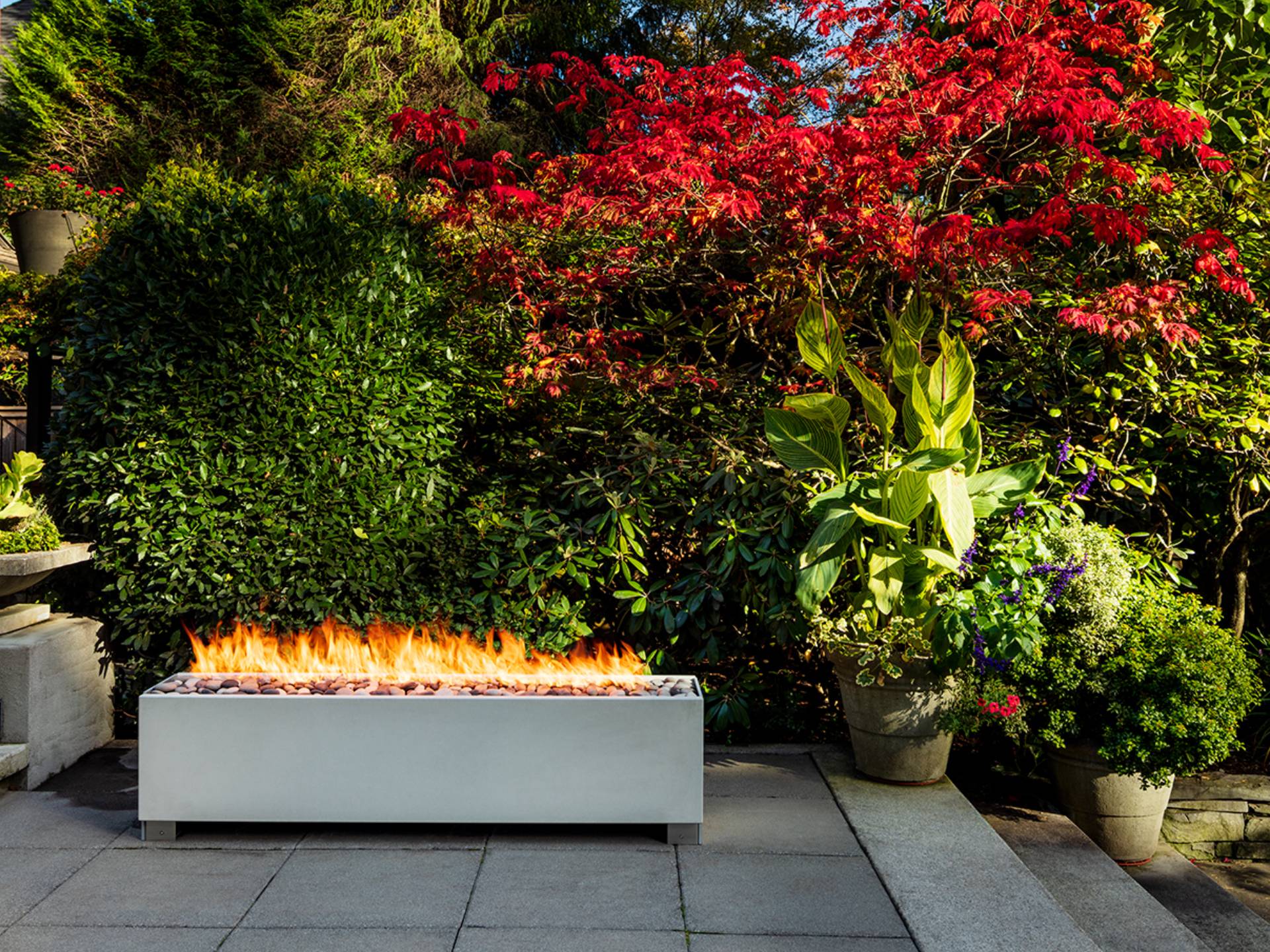
This Linear gas pit by Solus Decor is a high-end, high-quality option. It’s a modular unit, designed so that multiple heaters can be joined end to end for a full wall of fire, and stacked when not in use. It comes in 14 colours, and each unit has an output of 108,000 BTU, so will keep the largest garden cosy and warm through the evening. It costs from £6,510.
How to make your outdoor heating safe
Safety is always key when you’re using outdoor heating. Particularly if the potentially catastrophic combination of children, pets and open flames are all involved. There is no need to panic, though. There are several safety measures you can put in place to reduce the chances of anything going wrong.
Start with a flat surface: “The most pivotal thing you can do is to place the heater on a stable, flat surface to prevent it from tipping over,” says Adam Harper of Fire & Evacuation Services, a private fire service for businesses and event organisers. “For wood burners, I always recommend using a secure, non-flammable base.”
Create a barrier: “Installing a protective barrier around the heater is another effective way of keeping everyone safe,” adds Adam. “It should prevent any accidental contact, and it doesn’t have to be an ugly, obstructive barrier either. A decorative fire guard or a purpose-built screen will do the same job as an industrial-style fence. You may also want to consider using fire-resistant mats and screens to catch embers and prevent them from spreading. Especially if there are children, pets, flammable furniture or planting nearby.”
Check for gas leaks: For gas heaters, it’s always wise to check connections regularly for leaks. And ensure the shut-off valve is easily accessible,” warns Adam.
Light the fire correctly: “When it comes to lighting the fire, the trick is to build the fire slowly,” says Joanna Humphreys at Direct Stoves. “Use kindling, then pop a few natural firelighters in between to get the fire started. Avoid using petrol or any other flammable liquids that can cause sudden explosions or dangerous flames.”
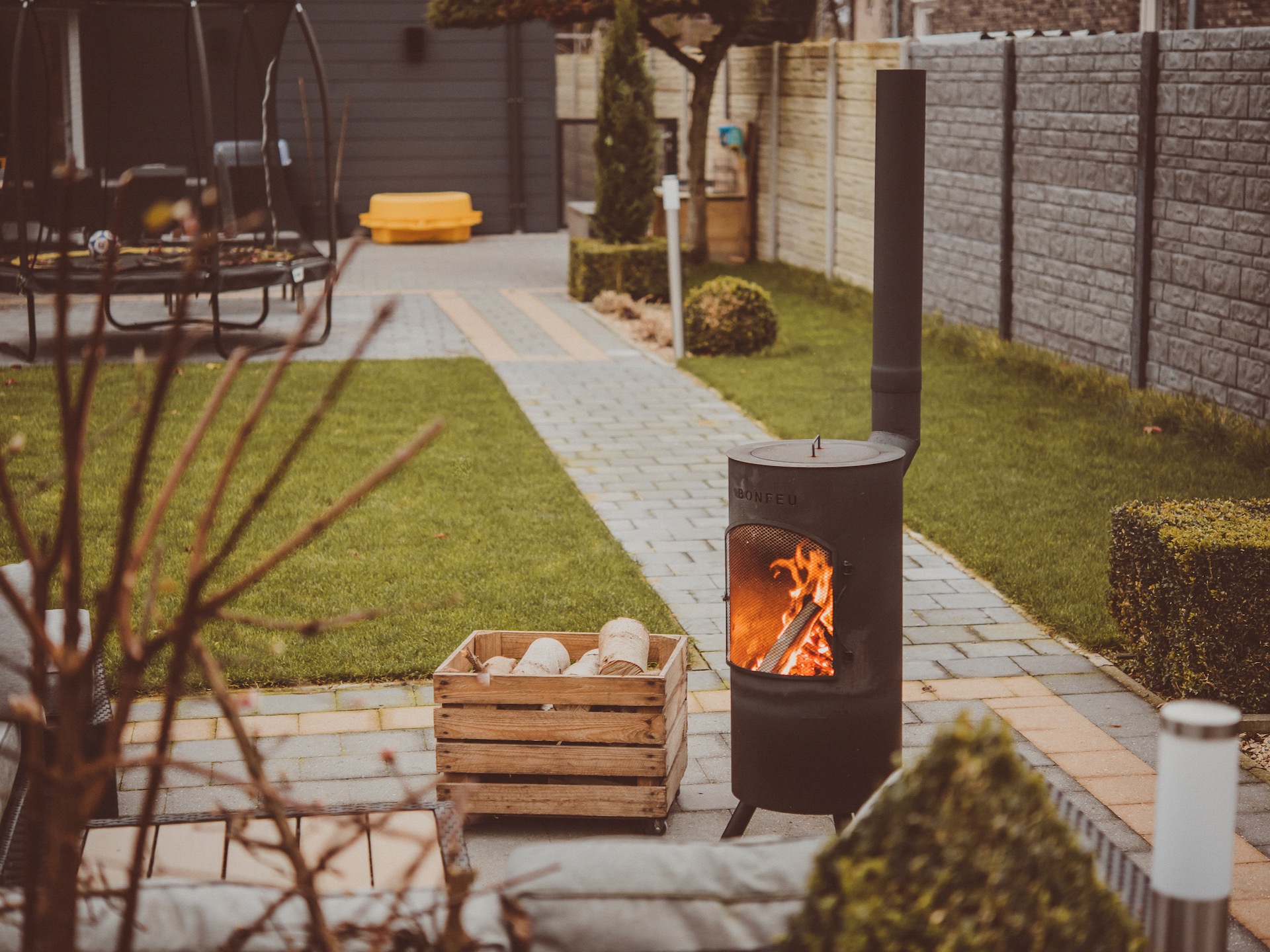
Never leave outdoor heating unattended: “It’s crucial to keep a watchful eye on the fire, especially if it’s a windy day,” says Joanna. “Strong gusts of wind can cause sparks to fly, causing damage to others or could quickly become a fire hazard.” And don’t leave the job to the kids – naked flames should always be watched over by a responsible adult.
Extinguish the fire safely: “Always make sure the fire is fully extinguished before leaving the area,” Joanna warns. “Douse the fire with water or sand and stir it around to ensure everything is thoroughly soaked. It’s important to not leave any hot ashes behind. Always make sure they are cold to the touch before disposing of them properly.”




